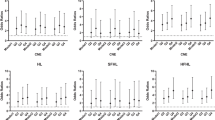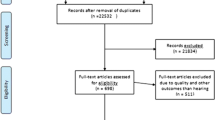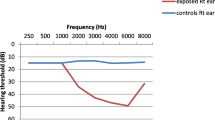Abstract
Objectives: The objective of this study was to review critically a number of occupational investigations of the exposure and effect relation between inhaled styrene vapour and hearing loss. There is concern that workers’ hearing may be impaired by exposure to styrene, as used in industries making plastics and fibreglass-reinforced products. Methods: Seven occupational studies, each dealing with the ototoxicity of styrene, were examined. Factors assessed included the experimental design and number of subjects within exposure groups, measurement of the styrene-in-air concentration, confirmation of the styrene exposure by blood or urine analysis, determination of the hearing threshold levels for the exposure and control groups, and measurement of any occupational noise in the subjects’ workplaces. Consideration was also given to statistical relations between high-frequency hearing loss and lifetime exposure indices for styrene and noise. Results: The results are equivocal. Four investigations failed to find any effect of styrene on hearing thresholds. In contrast, other investigations claimed to have demonstrated styrene-induced hearing loss in industrial populations, with synergism between styrene and noise. However, these reports exhibited shortcomings of experimental design and data analysis. Conclusions: Considering the body of evidence as a whole, hearing deficits due to occupational exposure to styrene at low concentrations have not been demonstrated by scientifically reliable argument. There is some suggestion of an association between styrene exposure, occupational noise, and hearing dysfunction. Further studies in humans are necessary to clarify this question.

Similar content being viewed by others
References
American Conference of Governmental Industrial Hygienists (2004) TLVs and BEIs Threshold Limit Values for chemical substances and physical agents, Biological Exposure Indices. ACGIH, Cincinnati
Bader M, Hungerland E, Triebig G (2000) Untersuchungen der äußeren und inneren styrolbelastung von beschäftigten einer bootswerft im zeitraum 1982–1999 (Investigations of styrene exposures in a boat manufacture in the period 1982–1999). Dokumentationsband der 40. Jahrestagung der Deutschen Gesellschaft für Arbeits- und Umweltmedizin e.V. 139–141. Rindt-Druck, Fulda. ISBN 3-7900-0325-5
Calabrese G, Martini A, Sessa G, Cellini M, Bartolucci GB, Marcuzzo G, De Rosa E (1996) Otoneurological study of workers exposed to styrene in the fiberglass industry. Int Arch Occup Environ Health 68:219–223
Cohen JT, Carlson G, Charnley G, Coggon D, Delzell E, Graham JD, Greim H, Krewski D, Medinsky M, Monson R, Paustenbach D, Petersen B, Rappaport S, Rhomberg L, Ryan PB, Thompson K (2002) A comprehensive evaluation of the potential health risks associated with occupational and environmental exposure to styrene. J Toxicol Environ Health B Crit Rev 5:1–263
Deutsche Forschungsgemeinschaft (2004) List of MAK and BAT values 2004: maximum concentrations and biological tolerance values at the workplace. Report no. 40. Wiley-VCH, Weinheim
Droz PO, Guillemin MP (1983) Human styrene exposure V: development of a model for biological monitoring. Int Arch Occup Environ Health 53:19–36
Greim H, Lehnert G (2002) Styrene. Biological exposure values for occupational toxicants and carcinogens. Critical data evaluation for BAT and EKA values, vol 4. Wiley-VCH, Weinheim. ISBN 3-527-27049-3
Guillemin MP, Bauer D (1979) Human exposure to styrene III. Elimination kinetics of urinary mandelic and phenylglyoxylic acids after single experimental exposure. Int Arch Occup Environ Health 44:249–263
Health and Safety Executive (2000) EH40/2000 Occupational exposure limits 2000. HSE Books, Sudbury
Ikeda M, Koizumi A, Miyasaka M, Watanabe T (1982) Styrene exposure and biologic monitoring in FRP boat production plants. Int Arch Occup Environ Health 49:325–339
Jensen AA, Breum NO, Bacher J, Lynge E (1990) Occupational exposures to styrene in Denmark 1955–88. Am J Ind Med 17:593–606
Lees PSJ, Stefaniak A, Emmett EA, Dalton P (2003) Exposure assessment for study of olfactory function in workers exposed to styrene in the reinforced-plastics industry. Am J Ind Med 44:12–23
Löf A, Brohede C, Gullstrand E, Lindström K, Sollenberg J, Wrangskog K, Hagberg M, Hedman BK (1993) The effectiveness of respirators measured during styrene exposure in a plastic boat factory. Int Arch Occup Environ Health 65:29–34
Mizunuma K, Yasugi T, Kawai T, Horiguchi S, Ikeda M (1993) Exposure–excretion relationship of styrene and acetone in factory workers: a comparison of a lipophilic solvent and a hydrophilic solvent. Arch Environ Contam Toxicol 25:129–133
Möller C, Odkvist L, Larsby B, Tham R, Ledin T, Bergholtz L (1990) Otoneurological findings in workers exposed to styrene. Scand J Work Environ Health 16:189–194
Morata TC, Johnson AC, Nylen P, Svensson EB, Cheng J, Krieg EF, Lindblad AC, Ernstgard L, Franks J (2002) Audiometric findings in workers exposed to low levels of styrene and noise. J Occup Environ Med 44:806–814
Morioka I, Kuroda M, Miyashita K, Takeda S (1999) Evaluation of organic solvent ototoxicity by the upper limit of hearing. Arch Environ Health 54:341–346
Muijser H, Hoogendijk EMG, Hooisma J (1988) The effects of occupational exposure to styrene on high-frequency hearing thresholds. Toxicology 49:331–340
Ramsey JC, Young JD, Karbowski RJ, Chenoweth MB, McCarthy LP, Braun WH (1980) Pharmacokinetics of inhaled styrene in human volunteers. Toxicol Appl Pharmacol 53:54–63
Sass-Kortsak AM, Corey PN, Robertson JM (1995) An investigation of the association between exposure to styrene and hearing loss. Ann Epidemiol 5:15–24
Sliwinska-Kowalska M, Zamyslowska-Smytke E, Szymczak W, Kotylo P, Fiszer M, Wesolowski W, Pawlaczyk-Luszczynska M (2003) Ototoxic effects of occupational exposure to styrene and co-exposure to styrene and noise. J Occup Environ Med 45:15–24
Takeda S, Morioka I, Miyashita I, Okumura A, Yoshida Y, Matsumoto K (1992) Age variation in the upper limit of hearing. Eur J Appl Physiol 65:403–408
Wolf K, Bienfat HG, Brohmann P, Brucksch E, Stanetzek I, Teuffel-Schilling C, Albracht G, Au M, Bolm-Audorff U (2000) Styrolbelastung von beschäftigten in der polyesterharz verarbeitenden industrie (Styrene exposure of workers in the polyester resins industry). Arbeitsmed Sozialmed Umweltmed 35:312–315
Acknowledgement
This review was prepared with financial support from the Styrenics Steering Committee of CEFIC, the European Chemical Industry Council. We thank Prof. Dr. P. Gelbke, BASF Ludwigshafen in Germany, for his helpful comments during the preparation of this review. The opinions expressed are those of the authors alone.
Author information
Authors and Affiliations
Corresponding author
Rights and permissions
About this article
Cite this article
Lawton, B., Hoffmann, J. & Triebig, G. The ototoxicity of styrene: a review of occupational investigations. Int Arch Occup Environ Health 79, 93–102 (2006). https://doi.org/10.1007/s00420-005-0030-2
Received:
Accepted:
Published:
Issue Date:
DOI: https://doi.org/10.1007/s00420-005-0030-2




